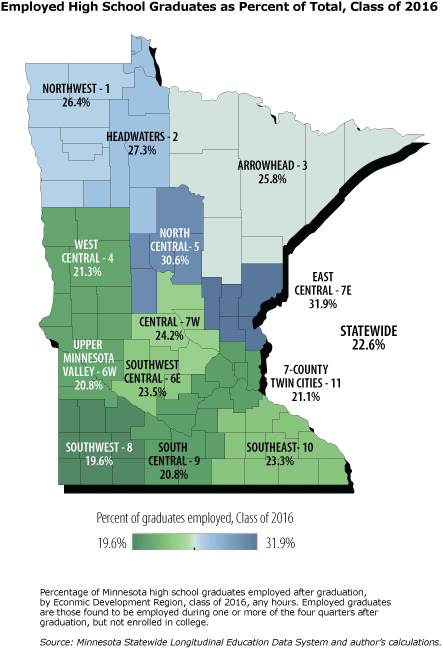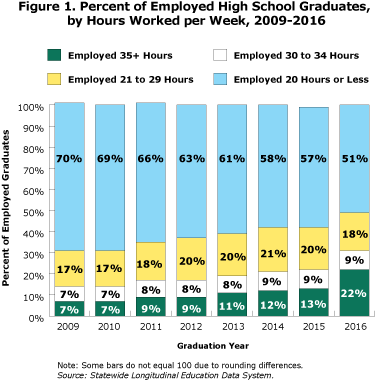by David Stokman
March 2019
As college tuition continues to rise,1 some high school graduates might wonder if college is worth the time and money, especially in a tight labor market where jobs are plentiful. In fact, a growing share of Minnesota high school graduates enter the workforce after graduation and find some success. While many students who forgo college face low pay and little upward mobility, many regions and industries across the state provide high school graduates with wages that meet the cost of living. This article examines statewide and regional trends for Minnesota high school graduates who did not go to college but instead entered the workforce between 2009 and 2016.
In Minnesota, the Statewide Longitudinal Education Data System, or SLEDS, helps us identify the pathways of students from school to the workforce including post-secondary education. In 2016, 69 percent of high school graduates enrolled in college in the fall after graduation, 23 percent of Minnesota high school graduates did not go on to college, but instead found employment during the year after graduation, and eight percent had unknown outcomes.2 Many of those who enrolled in college were also working, but for the purpose of this analysis employed graduates means those high school graduates who went into the workforce and did not enroll in college.
For the 23 percent of high school graduates who found work instead of attending college, the top industries of employment are shown in Table 1.
| Table 1. Top Industries of Employment for High School Graduates, Class of 2016 | |
|---|---|
| Industry | Employed, as a percent of total |
| Trade, Transportation and Utilities | 31% |
| Leisure and Hospitality | 25% |
| Education and Health Care and Social Assistance | 13% |
| Professional and Business Services | 11% |
| Construction | 6% |
| Manufacturing | 6% |
| Other Services | 4% |
| Financial Activities | 2% |
| Public Administration | 2% |
| Information | 1% |
| Natural Resources and Mining | 1% |
| Source: Statewide Longitudinal Education Data System | |
Displaying the data by Economic Development Region (EDR) reveals that, on average, the share of high school graduates entering the workforce rather than enrolling in college is highest in the northern half of the state (see map), but it has been expanding in almost every part of the state. Between 2009 and 2016, the EDRs that experienced the most growth in high school graduates entering the workforce are spread out across the state, with Northwest (EDR 1) coming in first at roughly 34 percent, followed by Southwest Central (EDR 6E) at just under 28 percent. Apart from Headwaters (EDR 2), every region experienced an expansion in the share of graduates entering the workforce during this time period.

Why did more high school graduates enter the workforce over this period? The trend can be mostly explained by a decline in unknown outcomes, rather than a decline in college enrollment. This may mean that more high school graduates who are not enrolled in college are finding employment, and finding it in Minnesota. This stronger employment outcome is likely a result of the tight labor market, with the unemployment rate at an 18-year low, and the number of job vacancies, at a series high (since 2001).
Looking at job vacancies, the share requiring a high school diploma/GED or less, increased from 59 to 64 percent over the seven-year period. Not only are there more job openings available to high school graduates, but there are also more full-time positions open. The share of full-time vacancies requiring a high school diploma/GED or less increased from 49 to 57 percent over the seven-year period.3 Clearly high school graduates have had increasing opportunities in the labor market over this period.
Overall, any type of post-secondary training is beneficial for employment and wage prospects. Reports vary, but many show that the lifetime earnings of a college graduate are about twice that of people with a high school diploma.4 Importantly, full-time employment is harder to secure without education or training beyond high school. Completers of any type of post-secondary award are roughly twice as likely to find full-time employment as high school graduates.5
However, it is also true that a growing number of college graduates face significant debt, with some working in occupations unrelated to their course of study or below their qualifications. Total student loan debt surpassed $1.5 trillion in first quarter 2018.6 For high school graduates unsure of where and what they want to study, entering the workforce may be the most economically viable option.
While less than a quarter of high school graduates find full-time employment7 in the year after graduation, this share has been trending upward. In 2009, 7 percent of high school graduates worked full-time compared to 22 percent in 2016 (Figure 1). From 2015 to 2016 alone, the percent of employed graduates working full-time increased from 13 to 22 percent. Additionally, for full-time employees, the average number of weekly hours worked increased from 40 to 448 during the same time period.

Wage prospects have been improving as well. Statewide, high school graduates' average hourly wages increased 25 percent from $10.00 in 2009 to $12.50 in 2016, an average annual increase of 3.6 percent, outpacing the rate of inflation over the same time period.9 High school graduates experienced increased purchasing power, meaning their paychecks went further at the grocery store and the pump.
Thanks to a tight labor market, high school graduates who aren't enrolled in college are more likely to find work in Minnesota, work full time and earn a living wage. If the strong labor market continues, we should continue to see wages and the demand for full-time workers increase. Despite these trends, obtaining education or training beyond high school is a good defense against market downturns.
1Average undergraduate fees and tuition at Minnesota public and private four-year institutions increased 37 and 48 percent respectively from 2007-2016.
2Unknown outcomes include graduates not found to be enrolled in college or employed in Minnesota. This could be students who are in school or working outside of Minnesota, are unemployed, or are not seeking work.
3This trend has continued into 2017/2018, as the number of job vacancies increased to 113,774 in fourth quarter 2017, with 68 percent of them requiring a HS diploma/GED or less. It should be noted that while some positions only require a high school diploma, they may still require relevant work experience.
4Lifetime Earnings by Degree Type. The Hamilton Project, 2017.
5Graduate Employment Outcomes, Minnesota DEED. Data used in the comparison are from 2016 for high school graduates and 2014 for post-secondary completers (the earliest year on record). Until recently, this difference was much greater.
7Full-time employment is defined by SLEDS as working in every quarter of the year immediately following graduation, and working at least 1,820 hours over the four quarters or, on average, 35 hours per week.
8SLEDS.
9Average annual inflation rate (CPI) was 1.57 percent over the seven-year stretch, 2009-2016, Minneapolis Federal Reserve Bank.